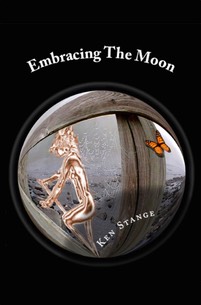"I'd have stopped writing years ago if it were for the money." --Paulo Coelho Link To Blog Archive here.
Oliver Wendall Holmes (Literary Clerihew) (2015-02-01)
Oliver Wendall Holmes (Literary Clerihew) (2015-02-01)
Oliver
Wendall Holmes’
never
wrote huge tomes
cuz Sherlock
took very little time
to
solve almost any ol’ crime.
Camus (Philosopher Clerihew) (2015-02-02)
Camus (Philosopher Clerihew) (2015-02-02)
Mister
Camus’
were not
a misanthrope’s views.
He just
knew the ‘meaning’ of existence
was essentially just nonsense.
Ernest Hemingway (Literary Clerihew) (2015-02-03)
Ernest Hemingway (Literary Clerihew) (2015-02-03)
Ernest
Hemingway
said
no f’ing way
he’d
prefer sunning on a beach in Rio de Janeiro
to boldly
climbing Mount Kilimanjaro
Leibniz (Philosopher Clerihew) (2015-02-04)
Leibniz (Philosopher Clerihew) (2015-02-04)
Gottfried
Wilhelm von Leibniz
had
fits
and made
an acrimonious fuss
about
Newton’s claim to have invented calculus.
F. Scott Fitzgerald (Literary Clerihew) (2015-02-05)
F. Scott Fitzgerald (Literary Clerihew) (2015-02-05)
F. Scott Fitzgerald
fancied himself the herald
of that twenties rage
we call ‘The Jazz Age’.
Aristotle (Philosopher Clerihew) (2015-02-06)
Aristotle (Philosopher Clerihew) (2015-02-06)
Aristotle
often
hit the bottle,
which
may explain why he thought logic
was so
god damned fantastic.
T. S. Elliot (Literary Clerihew) (2015-02-07)
T. S. Elliot (Literary Clerihew) (2015-02-07)
T.
S. Elliot
was
no idiot,
though
not nearly as profound
as
some of his poems try to sound.
Friedrich Nietzsche (Philosopher Clerihew) (2015-02-08)
Friedrich Nietzsche (Philosopher Clerihew) (2015-02-08)
Friedrich Nietzsche
could be pretty damn preachy
when
delivering his sermon
on
the temptations of women.
Good Enough (2015-02-09)
Good Enough (2015-02-09)
Watched the film Whiplash the other night, and it raises some interesting questions about motivating would-be artists. The story is about the interaction of a verbally abusive music teacher and one of his extremely promising students. The teacher justifies his abuse as necessary to push anyone with the potential to be great on to actually achieve greatness. The sadistic extent of the teacher’s abusiveness makes that assumption morally repugnant, but at one point in the film this teacher says something that does ring true. He says that to tell a student who fails to push himself that he did “good enough” is one of the worst things a teacher can say.
Teaching Creativity?! (2015-02-10)
Teaching Creativity?! (2015-02-10)
I’ve taught Creative Writing—at least that what I was being paid to do. But of course you can’t really teaching creative writing. The only thing you can do is show to your students some of the tools of the craft and how to use them. I view it as something like teaching a course on, say, printmaking. One can demonstrate how to make a lithograph or an acid etching. Technique can be taught. Creativity can’t.
Of course anyone taking a course on Creative Whatever already thinks they are creative. They just want to pick up a few tricks of the trade. Or least I hope that is what they expect to learn from me. It certainly is all I feel I can teach.
Encouraging Creativity? (2015-02-11
Encouraging Creativity? (2015-02-11)
I believe that a necessary but not sufficient component of creativity, or any significant accomplishment, is motivation. This brings me back to thinking about Whiplash. If you have a student who is creative, how do you encourage and nurture him or her?
I can’t pretend to know. The data is conflicting. Many creative people seem to be driven to increased effort by rejection. An “I’ll show you!” attitude motivates them. And there is solid research showing that many talented young people have lost interest in their talents if too often extrinsically rewarded by praise. And then, on the other hand, there is the fact that many an accomplished individual recalls receiving encouragement from a mentor when they were about to give up in despair.
For much of my life I have been obsessed with understanding the nature of creativity, and I’ve even written a trilogy of books on it. But I still wouldn’t presume to suggest a reliable way to encourage it.
Both Teachers And Art Require A Receptive Audience (2015-02-12)
Both Teachers And Art Require A Receptive Audience (2015-02-12)
I taught at Nipissing University for 40 years and am still teaching one course online about what science can contribute to our understanding of art and creativity. I never worried about ‘encouraging’ (or discouraging) my students. I only wanted to teach them the tools of the trade, the tools of critical, scientific thinking. I knew some would master use of these tools yet decline to use them. And I also knew that my caring deeply about what I was teaching made no difference if they weren’t receptive.
Art too is like that. How much a work of art affects you greatly depends on how much you willingly bring to it.
To Teach Or Not To Teach, That Is The Question (2015-02-13)
To Teach Or Not To Teach, That Is The Question (2015-02-13)
I once thought I’d choose teaching English to high school students for my day job. It was during my teenage years that I first came to deeply appreciate poetry, but most of my English teachers didn’t contribute to that. So I thought it would be profoundly rewarding to inspire appreciation of poetry in kids at that impressionable age.
It didn’t work out, largely because I was a lousy ‘education student’ who revolted against the same regimentation I’d had to endure in high school. I couldn’t see myself enforcing rules I found too absurd to adhere to myself. So when I was told to cut my hair before going to a particular class to ‘practice teach’, I decided teaching high school English wasn’t for me.
It turned out to be a good decision. The teaching I envisioned myself doing would be an all-consuming vocation and would leave little time for what I’d come to believe was my real calling,
And I wonder if, like teaching creative writing, teaching appreciation of poetry may be an impossible goal. One can give students the tools to appreciate poetry, but only they can choose to use them.
Formal Education And Creativity (2015-02-14)
Formal Education And Creativity (2015-02-14)
“Formal education and creativity mix about as successfully as oil and water, One would have to search long and hard to find an eminently creative person that actually liked the experience of formal education. And there aren’t many teachers who appreciate having to deal with a truly creative individual in their classroom.”
The Real Teachers (2015-02-15)
The Real Teachers (2015-02-15)
Our Real Teachers
.
“These teachers were invisible
discreet as sex and seasons’ change
they only spoke in happenings
their only lecture was our pain.
.
We all grew along their blackboards
until like angels we fell down
far smarter than we realized
they made our silence into sound.
.
They used our stretching bodies’ ache
and the high arching of our bones
to make their hard lessons
come home come home come home.”
(From my book: Bourgeois Pleasures)
Sleep Learning (2015-02-16)
Sleep Learning (2015-02-16)
For a Student Sleeping in a Poetry Workshop
I've watched his eyelids sag, spring open
Vaguely and gradually go sliding
Shut again, fly up
With a kind of drunken surprise, then wobble
Peacefully together to send him
Home from one school early. Soon his lashes
Flutter in REM sleep. I suppose he's dreaming
What all of us kings and poets and peasants
Have dreamed: of not making the grade,
Of draining the inexhaustible horn cup
Of the cerebral cortex where ganglions
Are ganging up on us with more connections
Than atoms in heaven, but coming up once more
Empty. I see a clear stillness
Settle over his face, a calming of the surface
Of water when the wind dies. Somewhere
Down there, he's taking another course
Whose resonance (let's hope) resembles
The muttered thunder, the gutter bowling, the lightning
Of minor minions of Thor, the groans and gurgling
Of feral lovers and preliterate Mowglis, the songs
Of shamans whistled through bird bones. A worried neighbor
Gives him the elbow, and he shudders
Awake, recollects himself, brings back
His hands from aboriginal outposts,
Takes in new light, reorganizes his shoes,
Stands up in them at the buzzer, barely recalls
His books and notebooks, meets my eyes
And wonders what to say and whether to say it,
Then keeps it to himself as today's lesson.
(From Collected Poems by David Wagoner)
A Clathic Inspiration (2015-02-17)
A Clathic Inspiration (2015-02-17)
Prof of Profs
For Allison Hogge, in memory of Brian Wilkie
I was a math major—fond of all things rational.
It was the first day of my first poetry class.
The prof, with the air of a priest at Latin mass,
told us that we could “make great poetry personal,”
could own it, since poetry we memorize sings
inside us always. By way of illustration
he began reciting Shelley with real passion,
but stopped at “Ozymandias, King of Kings;
Look on my Works, ye Mighty, and despair!”—
because, with that last plosive, his top denture
popped from his mouth and bounced off an empty chair.
He blinked, then offered, as postscript to his lecture,
a promise so splendid it made me give up math:
“More thingth like that will happen in thith clath.”
(Poem by Geoffrey Brock published in Poetry)
Laws Of Poetry (2015-02-18)
Laws Of Poetry (2015-02-18)
A friend sent me a web page entitled “Earl Gray’s Laws Of Poetry.” “Laws” is obviously being used ironically, for there are no laws of poetry. Poetry is a law onto itself. However, a poem should obey the rules the poet sets for it. That is wherein its power lies.
As Earl Gray says…
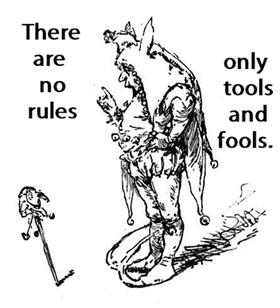
Bad Writing As Poetry? (2015-02-19)
Bad Writing As Poetry? (2015-02-19)
It’s interesting that because a poet can legitimately deviate from the conventions of prose to increase the effectiveness of the poem, some scribblers think the converse is true.

(Image credit: Earl Grey)
The Line Break Pseudosolution (2015-02-20)
The Line Break Pseudosolution (2015-02-20)
If you open a page and the lines don’t break precisely at the right margin, it is reasonable to assume you’re looking at a poem, for many poems do use the line break as a form of punctuation. But again the converse isn’t true, and again scribblers think it is.
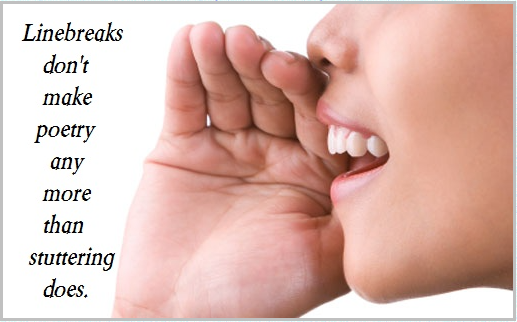
(Image credit: Earl Grey)
The Boredom Criterion (2015-02-21)
The Boredom Criterion (2015-02-21)
I’m sure the majority of people would say the reason they don’t read poetry is because it’s boring. Good poetry, of course, is the opposite of boring, but it often requires some effort on the part of the reader to appreciate it. (Most good art does.)
But my point here is that, yet again, scribblers don’t understand that the converse doesn’t have to be true. They seem to think that by writing something ‘difficult’ to understand, they must have created a poem.
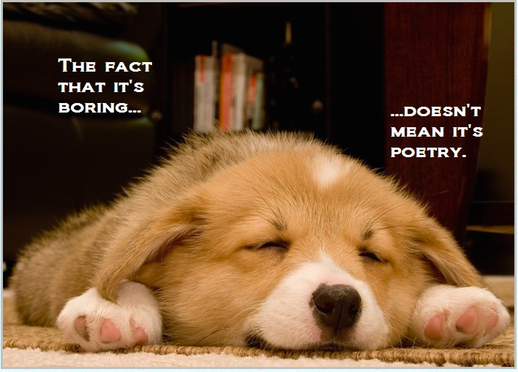
(Image credit: Earl Grey)
A Real Characteristic Poetry (2015-02-22)
A Real Characteristic Poetry (2015-02-22)
While poetry isn’t defined by line breaks or being difficult to understand, there is one characteristic that is essential to all poetry except the purely visual. And is the one consistently ignore by the scribblers.
It is the music of words.
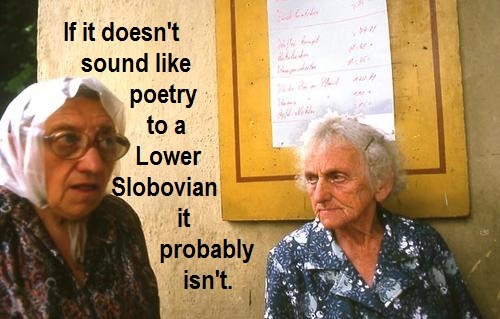
(Image credit: Earl Grey)
Sound And Sense (2015-02-23)
Sound And Sense (2015-02-23)
I have a book somewhere that was used as a textbook on poetry in one of my university classes, and it is aptly named: Sound and Sense. These are the two key components in real poetry. The competent poet has to be very concerned about how a poem sounds. A poem is like a piece of music in that its sense is partially, and often crucially, dependent on how it sounds.
For example, consider the prosodic (musical) structure of the limerick. (It consists of five lines in roughly anapestic meter rhyming AABBA. (The first, second and fifth lines have 3 metrical feet, while the third and fourth only have two.) Any poem conforming to this structure sounds humorous.
I’ve sometimes asked my students to try to write a convincingly sombre limerick. So far, none of them have succeeded.
The limerick packs laughs anatomical
Into space that is quite economical.
But don’t try serious
It will seem spurious
Such stern ones will still sound comical.
Sense And Sound (2015-02-24)
Sense And Sound (2015-02-24)
A stupid question: “What does that poem mean?”
A smart question: “What does that poem mean to you?"
The meaning of a poem is created by an individual’s interaction with the poem. So all poems have multiple meanings. Ambiguity in an instruction manual is a bad thing, but ambiguity is an important component of a poem.
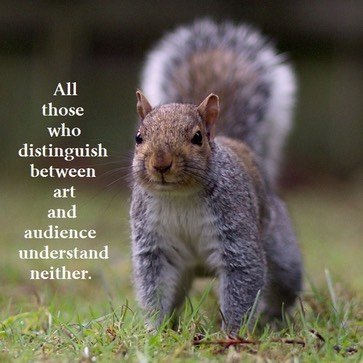
(Image credit: Earl Grey)
The Poet Or The Reader Versus The Poem (2015-02-25)
The Poet Or The Reader Versus The Poem (2015-02-25)
So much misunderstanding about poetry is based on egotism. Good poets aren’t writing poems about themselves, and good readers aren’t reading poems as personal messages to them. A poem is created by the interaction of poet and reader, which creates something entirely new. To think otherwise is like expecting water to be like either hydrogen or oxygen.
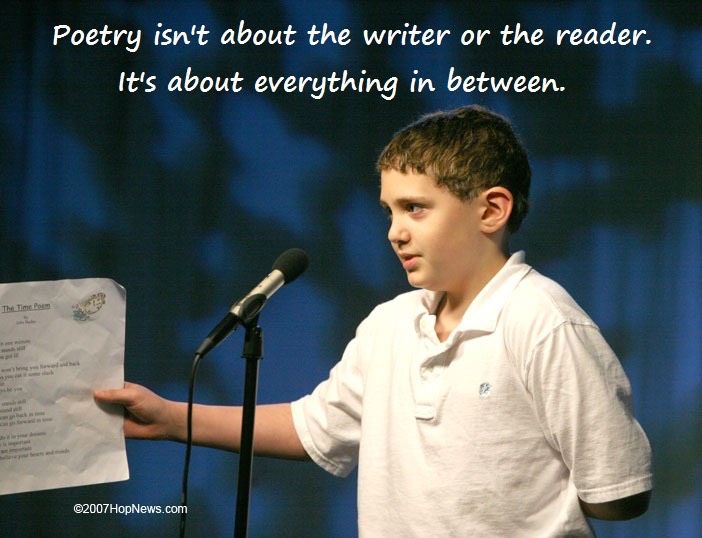
(Image credit: Earl Grey)
Sense And Appearance (2015-02-26)
Sense And Appearance (2015-02-26)
Aside from sound and sense, there is a third component that has increased in importance since the invention and refinement of printing: the appearance of the poem on the page. When poetry was primarily oral and literacy unusual this wasn’t a consideration. Now, however, and especially in the last hundred years, many poets have used a poem’s appearance to enhance its meaning—just as sound does. Here is an example by e.e. cummings who consistently used a poem’s appearance to enrich its meaning.
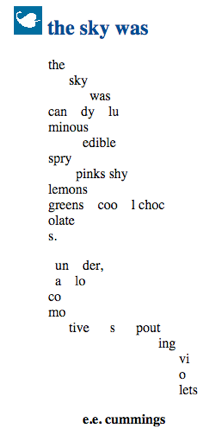
Poem As Image (2015-02-27)
Poem As Image (2015-02-27)
An extreme example of utilizing a poem’s appearance is what is usually called ‘concrete poetry’. Here the poem often is intended as an actual representation of what it is about. This criterion is so narrow that inevitably most of these are way too simplistic to be of serious interest. They’re almost always merely cute—or clever at best.
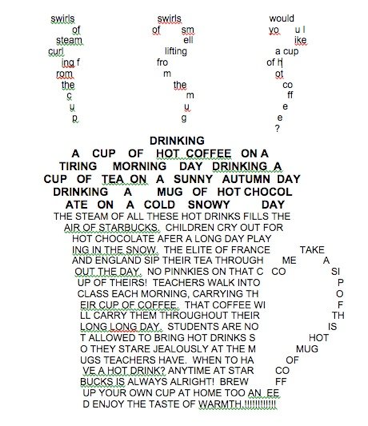
(Credit: Iron Monkey Interactive)
Merging Image And Text (2015-02-28)
Merging Image And Text (2015-02-28)
I’m a writer, so when I first began doing digital art, I set myself a single rule: each image had to contain a textual element. That way I could integrate my writing skills into my art. I decided to call my artworks “Constructions”, because I was constructing each artwork from a collection of separate components: a collection of images modified and merged and my text.
Construction 95, “Tanka Spheres”, is one series where the textual element was a formal poem in the tanka format that related to the image component. This series, along with an essay on the history and nature of the tanka and specific notes on the poems, was published as a book: Embracing The Moon: Twenty-Five Little Worlds.
